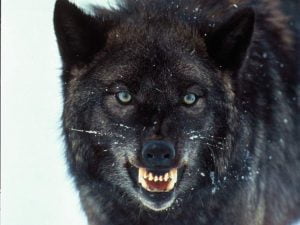
Dogs could save wolves, claim experts
 Last year’s TV program with Martin Clunes ‘A Man and his Dogs’ demonstrated how the domestic dog was descendent from wolves, and contained 99.8% wolf DNA. This surprised a lot of dog owners, but now scientists claim that the humble dog could enable its ancestor to survive, by offering some of its genetics back.
Last year’s TV program with Martin Clunes ‘A Man and his Dogs’ demonstrated how the domestic dog was descendent from wolves, and contained 99.8% wolf DNA. This surprised a lot of dog owners, but now scientists claim that the humble dog could enable its ancestor to survive, by offering some of its genetics back.
Genetic analysts have been studying wolves in Europe and America, and have found that North American wolves have developed darker coats through mating with domestic dogs, which has enabled them to adapt and survive in their new environments.
Stanford University’s Greg Barsh explains:
We usually think that dogs developed from wolves. The work shows an example where dogs gave something back to wolves.
It is believed that wolves with lighter coats are under threat as their habitats die out, and a darker coat could help them adapt easier.
Wolf expert Marco Musiani, who was involved in the research, states:
Domestication of dogs has led to dark-coloured coats in wolves, which has proven to be a valuable trait for wolf populations as their arctic habitat shrinks.
It also shows that human activities can help enrich the genetic diversity of wild animal populations, which is a very unexpected finding.
It is somewhat ironic that a trait that was created by humans may now prove to be beneficial for wolves as they deal with human-caused changes to their habitat.
It is believed by scientists that the black wolf is a product of grey wolves and domestic dogs breeding with each other approximately 10,000 years ago when the dogs were brought to the continent by Native Americans.
It also believed that the dogs themselves became extinct, and dogs that now live in America are descendants of European dogs.
Greg Barsh continued:
We were really surprised to find that domestic animals can serve as a genetic reservoir that can benefit the natural populations from which they were derived.
It’s also fascinating to think that a portion of the first Native American dogs, which are now extinct, may live on in wolves.
Wildlife biologists don’t really think that wolves rely much on camouflage to protect themselves or to increase their hunting success.
It’s possible there is something else going on here. For example, the protein responsible for the coat colour difference has been implicated, in humans, in inflammation and infection, and therefore might give black animals an advantage that is distinct from its effect on pigmentation.
wow really interesting!
with the humans being a good interaction, i say B******t. i would just leave wolves as is, they seem fine so far.
Having had the opportunity to observe in close proximity, three distinct groups of wolves, [eastern grey,Mackenzie,and arctic]I agree with the theory that at least the eastern grey wolf has had some interbreeding with dogs.
Not only are they darker than the Mackenzie and arctic wolves, the eastern wolf is usually shorter but of the same average weight as their cousins and fully able to inter breed, with viable offspring.
Well I like the idea but they will be part wolf not full wolf so I say both yes and no.
I didn’t really read this but wolves r evil!!! There are too many of them in Idaho now